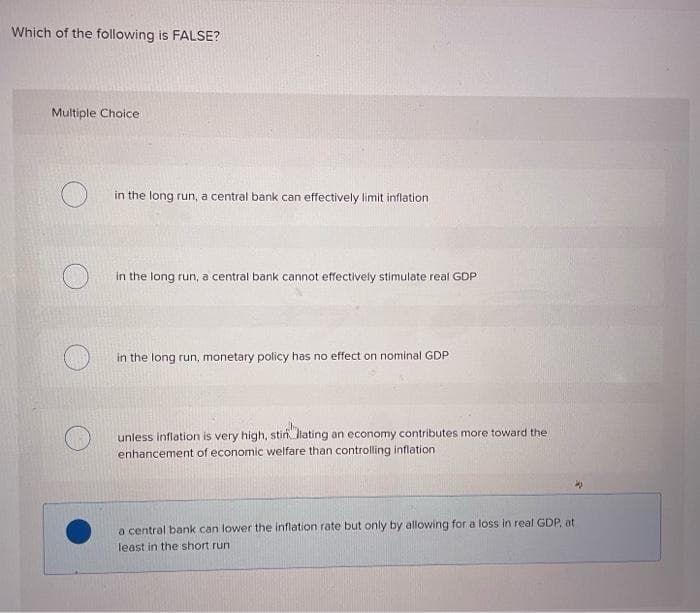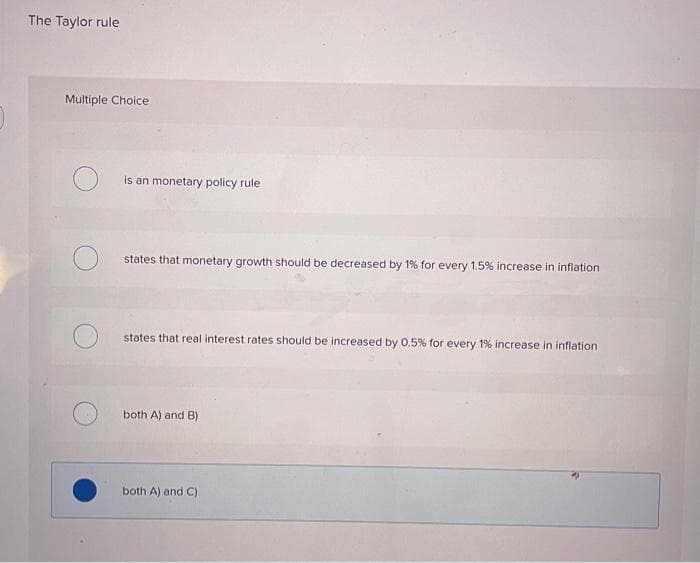Which of the following is FALSE? Multiple Choice in the long run, a central bank can effectively limit inflation in the long run, a central bank cannot effectively stimulate real GDP in the long run, monetary policy has no effect on nominal GDP unless inflation is very high, stin lating an economy contributes more toward the enhancement of economic welfare than controlling inflation a central bank can lower the inflation rate but only by allowing for a loss in real GDP, at least in the short run
Which of the following is FALSE? Multiple Choice in the long run, a central bank can effectively limit inflation in the long run, a central bank cannot effectively stimulate real GDP in the long run, monetary policy has no effect on nominal GDP unless inflation is very high, stin lating an economy contributes more toward the enhancement of economic welfare than controlling inflation a central bank can lower the inflation rate but only by allowing for a loss in real GDP, at least in the short run
Economics (MindTap Course List)
13th Edition
ISBN:9781337617383
Author:Roger A. Arnold
Publisher:Roger A. Arnold
Chapter16: Expectations Theory And The Economy
Section: Chapter Questions
Problem 2WNG
Related questions
Question

Transcribed Image Text:Which of the following is FALSE?
Multiple Choice
in the long run, a central bank can effectively limit inflation
in the long run, a central bank cannot effectively stimulate real GDP
in the long run, monetary policy has no effect on nominal GDP
unless inflation is very high, stin lating an economy contributes more toward the
enhancement of economic welfare than controlling inflation
a central bank can lower the inflation rate but only by allowing for a loss in real GDP, at
least in the short run

Transcribed Image Text:The Taylor rule
Multiple Choice
is an monetary policy rule
states that monetary growth should be decreased by 1% for every 1.5% increase in inflation
states that real interest rates should be increased by 0.5% for every 1% increase in inflation
both A) and B)
both A) and C)
Expert Solution
This question has been solved!
Explore an expertly crafted, step-by-step solution for a thorough understanding of key concepts.
This is a popular solution!
Trending now
This is a popular solution!
Step by step
Solved in 2 steps

Knowledge Booster
Learn more about
Need a deep-dive on the concept behind this application? Look no further. Learn more about this topic, economics and related others by exploring similar questions and additional content below.Recommended textbooks for you

Economics (MindTap Course List)
Economics
ISBN:
9781337617383
Author:
Roger A. Arnold
Publisher:
Cengage Learning


Economics (MindTap Course List)
Economics
ISBN:
9781337617383
Author:
Roger A. Arnold
Publisher:
Cengage Learning
